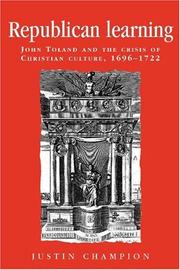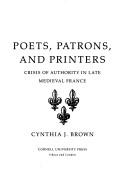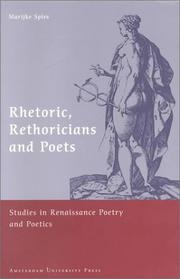| Listing 1 - 10 of 18 | << page >> |
Sort by
|
Book
ISBN: 1618112082 1618112090 9781618112095 9781618112088 9781618112088 1618118498 9781618118493 Year: 2014 Publisher: Brighton, Massachusetts Academic Studies Press
Abstract | Keywords | Export | Availability | Bookmark
 Loading...
Loading...Choose an application
- Reference Manager
- EndNote
- RefWorks (Direct export to RefWorks)
Between the years 1550 and 1650, Italy's Jewish intellectuals created a unique and enduring synthesis of the great literary and philosophical heritage of the Andalusian Jews and the Renaissance's renewal of perspective. While remaining faithful to the beliefs, behaviors, and language of their tradition, Italian Jews proved themselves open to a rapidly evolving world of great richness. The crisis of Aristotelianism (which progressively touched upon all fields of knowledge), religious fractures and unrest, the scientific revolution, and the new perception of reality expressed through a transformation of the visual arts: these are some of the changes experienced by Italian Jews which they were affected by in their own particular way. This book explores the complex relations between Jews and the world that surrounded them during a critical period of European civilization. The relations were rich, problematic, and in some cases strained, alternating between opposition and dialogue, osmosis and distinction.
Jewish learning and scholarship -- Italy -- History -- 16th century. --- Jewish learning and scholarship -- Italy -- History -- 17th century. --- Jews -- Italy -- History -- 16th century. --- Jews -- Italy -- History -- 17th century. --- Jews -- Italy -- Intellectual life -- 16th century. --- Jews -- Italy -- Intellectual life -- 17th century. --- Jews --- Jewish learning and scholarship --- Regions & Countries - Asia & the Middle East --- History & Archaeology --- Middle East --- History --- Intellectual life --- Hebrews --- Israelites --- Jewish people --- Jewry --- Judaic people --- Judaists --- Learning and scholarship --- Ethnology --- Religious adherents --- Semites --- Judaism --- Italy --- Jewish history --- Renaissance
Book
ISBN: 3830529961 Year: 2016 Publisher: Berlin, [Germany] : BWV Berliner Wissenschafts-Verlag,
Abstract | Keywords | Export | Availability | Bookmark
 Loading...
Loading...Choose an application
- Reference Manager
- EndNote
- RefWorks (Direct export to RefWorks)
Die Altmark schlägt die Brücke vom westelbischen Sachsen zum ostelbischen Landesausbaugebiet auf dem Boden slawischer Stämme und Völker, politisch, wirtschaftlich, ethnisch und kulturell. Bis zum Ende des 12. Jahrhunderts ostsächsische Grenzregion des Reiches und des Herzogtums Sachsen, wuchsen die Teilregionen auf dem Boden der sich erst nach und nach formierenden Altmark in den Machtkämpfen des Spätmittelalters zu einem der Hauptkreise der Mark Brandenburg zusammen. Die Altmark bewahrte aber vielerlei historische Wurzeln, bis zur Reformationszeit ihre Zugehörigkeit zu den sächsischen Bistümern Halberstadt und Verden, die enge Verflechtung der acht Immediatstädte mit Hansestädten, soziokulturelle Eigentümlichkeiten u.a.m., und auch in der Frühneuzeit, die den zeitlichen Schwerpunkt des Buches bildet, vielerlei Bezüge zu den politischen Nachbarn, den Fürstentümern Magdeburg und Halberstadt, Braunschweig und Lüneburg mit dem Wendland. Daraus erwächst von selbst der vergleichende Aspekt, wie er auch den ostelbischen Regionen der Mark Brandenburg gilt. Die Vergleiche heben die Merkmale hervor, die die Altmark bis zum Ende des Alten Reiches charakterisieren: eigenständige Gerichtsinstanzen, gute besitz- und personenrechtliche Verhältnisse der bäuerlichen Bevölkerung, eine auf verbriefte Privilegien wie auf angemaßte Observanzen pochende Ritterschaft, starke kommunale Kräfte in Stadt und Land, Bürgerschaften und Landgemeinden, die ihren Anspruch auf Selbst- und Mitbestimmung nicht aufgaben und auch im Zeitalter des Absolutismus um ökonomische, soziale und kulturelle Freiräume kämpften. Das manifestiert sich in vielfältigen, aus archivalischen Quellen ermittelten sozialen wie individuellen Handlungen, Verhaltens-, Lebens- und Denkweisen unterschiedlicher Interessengemeinschaften und gesellschaftlicher Gruppierungen in ihrem Mit- und Gegeneinander. Das Buch wendet sich sowohl an Fachkollegen der Landes-, Agrar- und Stadt-, Siedlungs-, Verfassungs-, Wirtschafts- und Sozial-, Kultur- und Alltagsgeschichte als auch an historisch Interessierte überhaupt, an Regional- und Ortshistoriker. Es bietet vielfältige neue Erkenntnisse und gibt Anstöße zum Weiterforschen.
Great Britain --- History --- History / Europe / Germany --- History / Modern / 16th Century --- History / Social History --- Annals --- Auxiliary sciences of history --- Politische Geschichte --- Kulturgeschichte --- Städtische Gesellschaft --- Ländliche Gesellschaft
Book
Year: 2022 Publisher: Heidelberg Heidelberg University Publishing (heiUP)
Abstract | Keywords | Export | Availability | Bookmark
 Loading...
Loading...Choose an application
- Reference Manager
- EndNote
- RefWorks (Direct export to RefWorks)
In search of subsidies for the publishing of his Greek and Latin oeuvre, the Corona Anni, Professor Martin Crusius of Tübingen (1526-1607) pointed out in a letter to Johan Papius, court physician at Ansbach, that it might teach even the Greeks to preach the word of God truly. At this point in time, Crusius could look back on nearly thirty years in which he had exerted himself body and soul for the dissemination of the Lutheran teaching among the Greek-speaking Christians. His 'mission' had begun when his former student Stephan Gerlach had been chosen to travel from the university town in Württemberg to Constantinople as embassy preacher in 1573. Up until his death, Crusius pursued his project of establishing the essentials for a Greek Lutheranism and sending these – at times on adventurous paths – to their recipients. Als der Tübinger Professor Martin Crusius (1526–1607) auf der Suche nach einem Druckkostenzuschuss für sein auf Griechisch und Latein verfasstes Lebenswerk, die Corona Anni, in einem Brief an den Ansbacher Hofarzt Johannes Pappius zu bedenken gab, Daraus kündten auch die Graeci lärnen, rain das Wort Gottes predigen, konnte er auf beinahe dreißig Jahre zurückblicken, in denen er sich mit Leib und Seele dafür eingesetzt hatte, die lutherische Lehre unter den griechischsprachigen Christen zu verbreiten. Seine „Mission“ hatte begonnen, als sein ehemaliger Student Stephan Gerlach ausgewählt wurde, im Jahre 1573 als Botschaftsprediger aus der württembergischen Universitätsstadt nach Konstantinopel, der Hauptstadt des Osmanischen Reiches, zu reisen. Bis zu seinem Tod verfolgte Crusius das Vorhaben, die Grundlagen für ein Luthertum der Griechen zu schaffen und diese – teilweise auf abenteuerlichen Wegen – zu den Adressaten zu schicken.

ISBN: 0719080495 0719057140 9786610733910 1847790437 1781700257 1280733918 1417582693 9781526137630 9781847790439 9781417582693 6610733910 1526137631 9780719080494 9780719057144 9781280733918 9781781700259 1847795307 Year: 2003 Publisher: Manchester ; New York : New York : Manchester University Press ; Distributed exclusively in the USA by Palgrave,
Abstract | Keywords | Export | Availability | Bookmark
 Loading...
Loading...Choose an application
- Reference Manager
- EndNote
- RefWorks (Direct export to RefWorks)
This volume explores the life, thought and political commitments of the free-thinker John Toland (1670-1722). Studying both his private archive and published works, it illustrates how Toland moved in both subversive and elite political circles in England and abroad ... The book explores the connections between Toland's republican political thought and his irreligious belief about Christian doctrine, the ecclesiastical establishment and divine revelation, arguing that far from being a marginal and insignificant figure, he counted queens, princes and government ministers as his friends and political associates ... Overall, it illustrates how Toland's ideas and influence impacted upon English political life between the 1690's and the 1720's.
Great Britain - Church history - 16th century. --- Toland, John. --- Regions & Countries - Europe --- Philosophy & Religion --- History & Archaeology --- Great Britain --- Philosophy --- Toland, John, --- Influence. --- Church history --- Politics and government --- Philosophers --- Patricola, --- Scholars --- toland --- religion --- hanoverian --- John Toland --- Melbourne University Publishing --- Moses --- Republicanism
Book
ISBN: 3830522118 Year: 2017 Publisher: Berlin, [Germany] : Berliner Wissenschafts-Verlag,
Abstract | Keywords | Export | Availability | Bookmark
 Loading...
Loading...Choose an application
- Reference Manager
- EndNote
- RefWorks (Direct export to RefWorks)
Spannend schildert der Autor den Wandel des niederlausitzischen Landvogtamtes in den Jahren von 1490 bis 1620. Er zeichnet nicht nur ein Bild von den Persönlichkeiten der Landvögte, von ihren familiären Hintergründen, ihren politischen Karrieren und den Gründen ihrer Amtseinführung, sondern geht auch auf das Verhältnis zwischen dem König und den niederlausitzischen und böhmischen Ständen ein. Denn im 15. Jahrhundert kam ein neuer Machtfaktor ins Spiel - die Stände, die über das Schicksal ihres Landes mitentscheiden wollten und dafür einen schwachen Landvogt aus eigenen Reihen einem treuen Diener des Königs vorzogen. Der Autor verweist im notwendigen Maß auch auf das Geschehen in den übrigen Ländern der Böhmischen Krone und erfasst die Veränderung in den Kompetenzen der Landvögte sowie die Funktion und personelle Besetzung ihres Amtsapparates. Mit dieser breiten Fragestellung und dem großen Umfang der ausgewerteten Quellen unterscheidet sich diese historische Darstellung grundlegend von anderen Abhandlungen, die bisher zum Thema verfasst worden sind.
Lower Lusatia (Germany) --- History. --- Lusatia, Lower --- Niederlausitz (Germany) --- Lusatia, Lower (Germany) --- History / Europe / Germany --- History / Modern / 16th Century --- History / Social History --- History --- Annals --- Auxiliary sciences of history --- Niederlausitz --- Königreich Böhmen --- Landvogtsamt --- Ständeordnung
Book
ISSN: 18744834 ISBN: 9789004340305 9004340300 9789004340312 9004340319 Year: 2017 Volume: 60 45 Publisher: Leiden Brill
Abstract | Keywords | Export | Availability | Bookmark
 Loading...
Loading...Choose an application
- Reference Manager
- EndNote
- RefWorks (Direct export to RefWorks)
This volume offers an expansive survey of the role of single-sheet publishing in the European print industry during the first two centuries after the invention of printing. Drawing on new materials made available during the compilation of the Universal Short Title Catalogue, the twenty contributors explore the extraordinary range of broadsheet publishing and its contribution to government, pedagogy, religious devotion and entertainment culture. Long disregarded as ephemera or cheap print, broadsheets emerge both as a crucial communication medium and an essential underpinning of the economics of the publishing industry.
094:93 <041> --- 655.4 <0.02> --- 655.4 <0.02> Uitgeverij. Boekhandel--Documenten naar hun fysieke vorm en uiterlijk --- Uitgeverij. Boekhandel--Documenten naar hun fysieke vorm en uiterlijk --- Oude drukken i.v.m. geschiedenis--Brochures. Pamfletten. Essays --- 094:93 <041> Oude drukken i.v.m. geschiedenis--Brochures. Pamfletten. Essays --- broadsides [notices] --- Book history --- Graphics industry --- anno 1400-1499 --- anno 1600-1699 --- anno 1500-1599 --- Europe --- Printing industry --- Broadsides --- Communication --- History --- Intellectual life --- Economic conditions --- Édition --- Placard --- --Communication --- --Histoire économique --- --Condition économique --- --Vie intellectuelle --- --Europe --- --XVIe-XVIIe s., --- 5967 --- --Placard --- E-books --- Broadsides. --- Communication. --- Economic history. --- Intellectual life. --- Printing industry. --- Manufacturing industries --- Cultural life --- Culture --- History, Economic --- Economics --- Communication, Primitive --- Mass communication --- Sociology --- Ballad-sheets --- Broadsheets --- Broadside ballads --- Journalism --- Street literature --- 1500-1699 --- Europe. --- Council of Europe countries --- Eastern Hemisphere --- Eurasia --- Printing industry - Europe - History - 16th century --- Printing industry - Europe - History - 17th century --- Broadsides - Europe - History - 16th century --- Broadsides - Europe - History - 17th century --- Communication - Europe - History - 16th century --- Communication - Europe - History - 17th century --- Histoire économique --- Condition économique --- Vie intellectuelle --- XVIe-XVIIe s., 1501-1700 --- Europe - Intellectual life - 16th century --- Europe - Intellectual life - 17th century --- Europe - Economic conditions - 16th century --- Europe - Economic conditions - 17th century. --- Early modern history: c 1450/1500 to c 1700
Book
ISSN: 21072566 ISBN: 9782869065239 9782753573161 2753573166 286906523X 2869066759 Year: 2017 Publisher: Tours Presses universitaires François Rabelais de Tours
Abstract | Keywords | Export | Availability | Bookmark
 Loading...
Loading...Choose an application
- Reference Manager
- EndNote
- RefWorks (Direct export to RefWorks)
Charlotte Guillard constitue une figure exceptionnelle de la Renaissance française. Originaire du Maine, elle mène à Paris une carrière brillante dans la typographie. Veuve tour à tour des imprimeurs Berthold Rembolt et Claude Chevallon, elle administre en maîtresse-femme l'atelier du Soleil d'Or pendant près de vingt ans, de 1537 à 1557. Sous sa direction, l'entreprise accapare le marché de l'édition juridique et des Pères de l'Église, publiant des éditions savantes préparées par quelques-uns des plus illustres humanistes parisiens (Antoine Macault, Jacques Toussain, Jean Du Tillet, Guillaume Postel...). Associant dans un même projet intellectuel les théologiens parisiens les plus conservateurs et les lettrés les plus épris de nouveauté, sa production témoigne de la vivacité des débats qui agitent les milieux intellectuels au siècle des Réformes.
Women printers
---
Printing
---
Books
---
Printers
---
History
---
Guillard, Charlotte,
---
Guillard, Charlotte
---
Printing, Practical
---
Typography
---
Women as printers
---
Guillard, Carola,
---
Guillart, Charlotte,
---
094.1 <44 PARIS>
---
929-055.2
---
929-055.2 Biografie. Genealogie. Heraldiek--Vrouwelijke personen. Vrouwen
---
Biografie. Genealogie. Heraldiek--Vrouwelijke personen. Vrouwen
---
094.1 <44 PARIS> Oude drukken: bibliografie--


ISBN: 0801430712 150174254X 1501742531 Year: 1995 Publisher: Ithaca (N.Y.) Cornell university press
Abstract | Keywords | Export | Availability | Bookmark
 Loading...
Loading...Choose an application
- Reference Manager
- EndNote
- RefWorks (Direct export to RefWorks)
Cynthia J. Brown explains why the advent of print in the late medieval period brought about changes in relationships among poets, patrons, and printers which led to a new conception of authorship.Examining such paratextual elements of manuscripts as title pages, colophons, and illustrations as well as such literary strategies as experimentation with narrative voice, Brown traces authors' attempts to underscore their narrative presence in their works and to displace patrons from their role as sponsors and protectors of the book. Her accounts of the struggles of poets, including Jean Lemaire, Jean Bouchet, Jean Molinet, and Pierre Gringore, over the design, printing, and sale of their books demonstrate how authors secured the status of literary proprietor during the transition from the culture of script and courtly patronage to that of print capitalism.
Poetry
---
Book history
---
Industrial and intellectual property
---
French literature
---
anno 1500-1599
---
France
---
Authors and publishers
---
Authorship
---
Copyright
---
Literature publishing
---
Renaissance
---
History
---
091 <44>
---
094.1 <44>
---
840-1 "14/15"
---
930.85.42 <44>
---
-Authorship
---
-Copyright
---
-Renaissance
---
-Literature publishing
---
-Literary publishing
---
Literature
---
Publishers and publishing
---
Revival of letters
---
Civilization
---
History, Modern
---
Civilization, Medieval
---
Civilization, Modern
---
Humanism
---
Middle Ages
---
Literary property
---
Property, Literary
---
Intangible property
---
Intellectual property
---
Anti-copyright movement
---
Book registration, National
---
Patent laws and legislation
---
Authoring (Authorship)
---
Writing (Authorship)
---
Author and publisher
---
Publishers and authors
---
Publishing contracts
---
Contracts
---
Book proposals
---
Literary agents
---
Handschriftenkunde. Handschriftencatalogi--Frankrijk
---
Oude drukken: bibliografie--

ISBN: 9053564004 9786611972325 1281972320 9048505763 9789048505760 9781281972323 9789053564004 Year: 1999 Publisher: Amsterdam Amsterdam university press
Abstract | Keywords | Export | Availability | Bookmark
 Loading...
Loading...Choose an application
- Reference Manager
- EndNote
- RefWorks (Direct export to RefWorks)
A tribute to Marijke Spies on her retirement as professor of 16th- and 17th-century Dutch literature.
Rhetoric, Renaissance. --- European literature --- History and criticism --- Theory, etc. --- Poetics --- Rhetoric, Renaissance --- 839.3 "15/16" --- Renaissance rhetoric --- 839.3 "15/16" Nederlandse literatuur--?"15/16" --- Nederlandse literatuur--?"15/16" --- History and criticism&delete& --- Theory, etc --- History --- Rhetoric [Renaissance ] --- Rhetoric --- Netherlands --- 16th century --- 17th century --- Dutch literature --- 1500-1800 --- French literature --- Latin literature [Medieval and modern ] --- Humanism --- cultuur and geschiedenis --- dutch and flemish literature --- nederlandse en vlaamse literatuur --- culture and history
Book
ISBN: 0520965469 9780520965461 0520291832 9780520291836 Year: 2016 Publisher: Oakland, California University of California Press
Abstract | Keywords | Export | Availability | Bookmark
 Loading...
Loading...Choose an application
- Reference Manager
- EndNote
- RefWorks (Direct export to RefWorks)
"How did the patronage activities of the Vijayanagara Empire (c. 1346-1565) influence Hindu sectarian identities? Contrary to most portraits of the empire as a Hindu bulwark against Islamic incursion from the north or as a religiously ecumenical state, in Polemics and Patronage in the City of Victory, Valerie Stoker argues that the Vijayanagara court was selective in its patronage of religious institutions. But the motivations behind this selectivity were not always religious. To understand the dynamic interaction between religious and royal institutions in this period, she focuses on the career of the Hindu intellectual and monastic leader Vyāsatīrtha. An agent of the state and a powerful religious authority, Vyāsatīrtha played an important role in expanding the empire's economic and social networks. By examining Vyāsatīrtha's polemics against rival sects in the context of his work for the empire, Stoker provides a remarkably nuanced picture of the relationship between religious identity and socio-political reality under Vijayanagara rule"--Provided by publisher.
Hinduism and state --- History --- Vyāsatīrtha, --- Influence. --- Vijayanagar (Empire) --- Religion --- State and Hinduism --- Vyāsarāja, --- Vyāsarāya, --- Vijayanagar, India --- State, The --- Chandrikacharya, --- HISTORY / Asia / India & South Asia. --- 16th century. --- academic. --- ally. --- ancient city. --- city of victory. --- empire. --- government. --- hindu. --- historical. --- india. --- indian government. --- indian history. --- indian politics. --- krishna river. --- military. --- polemics. --- political. --- religion. --- rival. --- rulers. --- scholarly. --- sectarian. --- social life. --- south india. --- translation. --- urban. --- vijayanagara empire. --- world history.
| Listing 1 - 10 of 18 | << page >> |
Sort by
|

 Search
Search Feedback
Feedback About UniCat
About UniCat  Help
Help News
News